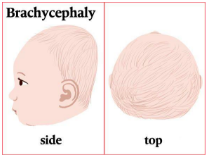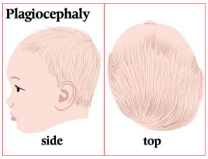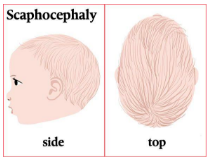What Causes Abnormal Head Shape in Babies?
As pediatric physical therapists, we commonly treat babies that have atypical or asymmetrical head shapes as a result of positioning or a variety of other factors. With early intervention, a number of techniques and positioning strategies can halt this asymmetrical shaping and avoid corresponding facial asymmetries that are often seen in conjunction with abnormal head shape. This article explores some common causes to head shape changes in infants and reviews treatments options and goals of helping a child’s head achieve a more symmetrical shape.
Some of the most common causes in head shape changes of an infant include:
- Womb position – If a baby is breech in orientation, very low in the mother’s pelvis, rotated and does not have much movement in utero or is a multiple, at times, infants can be born with head shape anomalies due to prolonged positioning in utero.
- Premature birth – These babies are born early and have especially soft skulls, making them more susceptible to misshaping. These babies are often in the NICU (neo-intensive-care unit) for extended periods of time, where the infants may be hooked up to machines causing the head to be fixed in one position. They also lack the head control at an early age to maintain their heads in midline, and are often fully rotated to the right or the left.
- Torticollis – Torticollis is a condition that results in a head tilt and rotational preference due to a tight and inflexible muscle. Torticollis often causes the head to be held in a fixed position which can lead to flatness on one side of the back of the head.
- Carriers and Convenience Devices – Car seats, bouncy seats and swings often have rigid and unyielding surfaces for a child’s head to rest against. Though normal use is not a concern, extended use and allowing an infant to sleep in a positional device increases the risk of abnormal head shape.
- Back sleeping – The American Academy of Pediatrics recommends infants to sleep on their backs to prevent SIDS. They are also recommend frequent rotation of baby’s head as well as supervised tummy time, to counter this prolonged positioning on the infants back at night.
What are the types of abnormal head shapes in an infant?
Brachycephaly Head Shape
|
 |
Plagiocephaly Head Shape
|
 |
Scaphocephaly Head Shape
|
 |
How common is plagio/brachy/scaphocephaly?
1 in 250 infants are born with torticollis and as many as 1 in 4 babies can have an abnormal head shape. Back to sleep has increased rates of both issues, but also since infant carriers now easily snap into car seats and strollers, infants tend to spend longer periods in contained and rigid spaces.
Why treat abnormal head shapes?
Studies have found developmental delays in infants, toddlers and preschoolers with abnormal head shapes when compared to children with typical or symmetrical head shapes. However, abnormal head shapes do not cause developmental delays. In fact, it may be the opposite. Researchers think the condition may be a “marker” that could identify if a child is at risk for delayed development. They recommend that all babies with flattened skulls be screened for developmental problems.
Head flatness can also look like craniosynostosis, which is when one or more of the soft sutures in a baby’s skull close or fuse earlier than normal. Over time, in the child’s skull, the sutures close and connect the skull bones. There are different sutures that close at different times, starting at about 3 to 9 months. The process continues through adulthood. However, when these seams close too early, it changes the shape of baby’s skull, causing asymmetries in the shape. This can increase pressure in the skull and affect brain development. It also requires surgical intervention to properly address.
What are treatments to affecting a baby’s head shape?
Home exercise programs are commonly recommended by a pediatric physical therapist to address abnormal postures with infants, which could lead to skull reshaping. Supervised tummy time and repositioning techniques are most used to prevent and improve abnormal head shape. Facial exercises, massage and taping can also help with repositioning of a child, and in turn, affect their head shaping.
If head shapes do not continue to improve with repositioning techniques for several weeks, a cranial orthotic, or helmet, may be recommended. Typically, this orthotic is applied at four months for optimal results and can be effective up to 18 months of age. There are several types of cranial helmets or bands for reshaping an infant’s head. They work by creating a negative space for the flattened area of the skull to grow into, keeping contact from a firm surface from further impacting the shape of their skull. The foam liner of the helmets is then reassessed weekly or every two weeks to assure contact is appropriate. As the skull grows, the foam is slowly shaved out to help reshape the skull into a more symmetrical end result.
Where do I go from here?
If you have concerns regarding your child’s skull shape or corresponding facial symmetries, please call our office – 773-687-9241 – for an assessment with a skilled, pediatric physical therapist to determine if a repositioning schedule along with strengthening exercises can be effective interventions for your child. Research has shown that intervention prior to three months of age can greatly improve results and decrease the overall treatment time required to achieve symmetrical motor skills and corresponding skull and facial symmetries. A good rule of thumb: When in doubt, DON’T WAIT!


